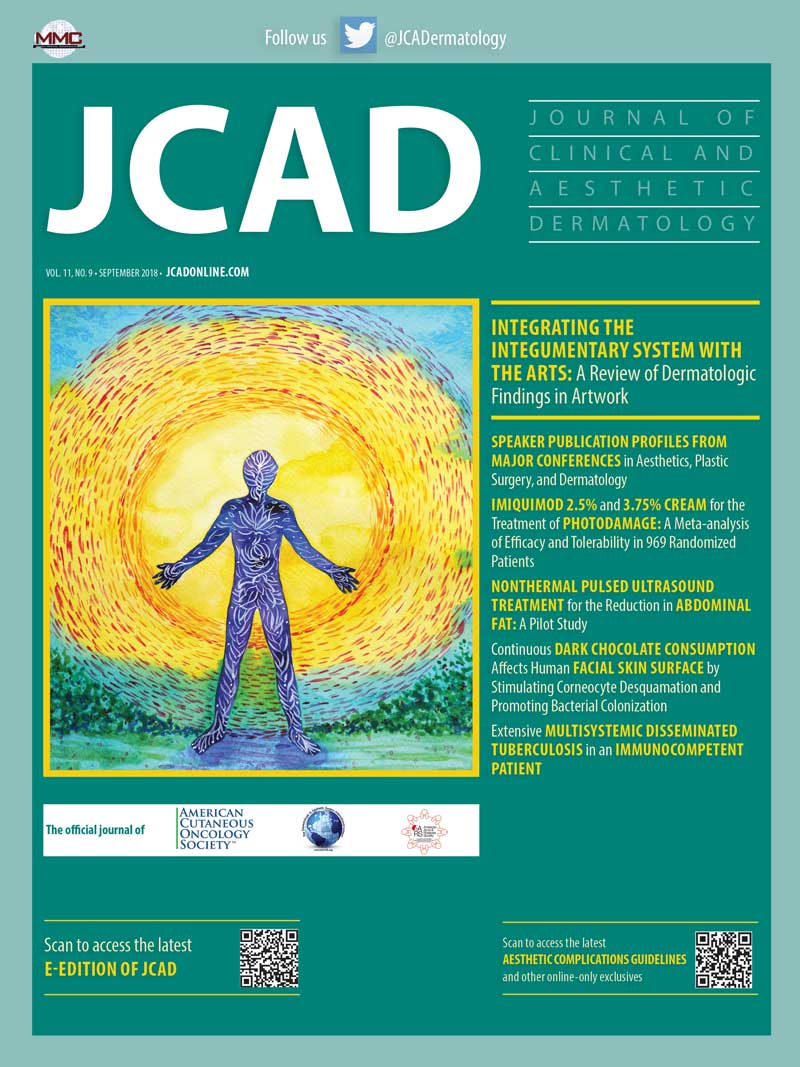Dear Colleagues:
 Welcome to the September 2018 issue of The Journal of Clinical and Aesthetic Dermatology. We start this issue with a study by Jandhyala titled “Speaker Publication Profiles from Major Conferences in Aesthetics, Plastic Surgery, and Dermatology.” Here, the author compares the scientific backgrounds of speakers at major conferences related to aesthetic medicine. The author reports that the results of his analysis indicate the quality of aesthetic doctors who present at medical conferences “might fall below the threshold deemed acceptable for doctors presenting themselves as experts in a branch of medicine.” The author discusses his results.
Welcome to the September 2018 issue of The Journal of Clinical and Aesthetic Dermatology. We start this issue with a study by Jandhyala titled “Speaker Publication Profiles from Major Conferences in Aesthetics, Plastic Surgery, and Dermatology.” Here, the author compares the scientific backgrounds of speakers at major conferences related to aesthetic medicine. The author reports that the results of his analysis indicate the quality of aesthetic doctors who present at medical conferences “might fall below the threshold deemed acceptable for doctors presenting themselves as experts in a branch of medicine.” The author discusses his results.
Next, in a review article titled, “Integrating the Integumentary System with the Arts: A Review of Dermatologic Findings in Artwork,” by Om and Om, the authors review portraits through the centuries that depict various dermatologic conditions. The authors suggest “that the arts might be more interconnected to the sciences than traditionally acknowledged.”
Following this, in a meta-analysis by Del Rosso et al titled “Imiquimod 2.5% and 3.75% Cream for the Treatment of Photodamage: A Meta-analysis of Efficacy and Tolerability in 969 Randomized Patients,” investigators assessed the efficacy and tolerability of imiquimod 3.75% and 2.5% cream for the treatment of photodamage in patients with actinic keratosis (AK) of the full face or balding scalp. Based on the results of their analysis, the authors report that both imiquimod 2.5% and 3.75% creams appear to have a positive effect on photodamage when compared with the vehicle cream. The authors discuss their results.
Next, Weinstein et al present the results of their study titled, “Nonthermal Pulsed Ultrasound Treatment for the Reduction in Abdominal Fat: A Pilot Study.” Here, the researchers evaluate the effectiveness of a nonthermal focused ultrasound device for the noninvasive removal of excess abdominal fat among 10 healthy female subjects. The authors report that the treatments were effective and well tolerated, with no adverse events, concluding that the study device appears to be a safe, effective, noninvasive treatment option for the removal of unwanted abdominal fat deposits.
Following this, in the study by Chalyk et al titled, “Continuous Dark Chocolate Consumption Affects Human Facial Skin Surface by Stimulating Corneocyte Desquamation and Promoting Bacterial Colonization,” the investigators evaluate the effects that dark chocolate consumption has on morphological characteristics of the residual skin surface components (RSSCs) of facial skin of young and middle-aged men. The authors report that chocolate consumption caused a significant increase in corneocyte desquamation in the group of young men and that the presence of Gram-positive microorganisms increased in both the young and middle-aged groups of men, particularly in the young men. The authors discuss the implications of their results.
And finally, in a case report by Kaur et al titled, “Extensive Multisystemic Disseminated Tuberculosis in an Immunocompetent Patient,” the authors describe a case of disseminated tuberculosis in an adult immunocompetent man who presented with morphologically different types of cutaneous lesions. The authors describe the assessment, differential diagnoses, and treatment of the patient, as well as provide a discussion on this form of tuberculosis.
We hope you enjoy this issue of JCAD, and as always we welcome your feedback and submissions.
With regards,
James Q. Del Rosso, DO, FAOCD—Editor-in-Chief, Clinical Dermatology
Wm. Philip Werschler, MD, FAAD, FAACS—Editor-in-Chief, Aesthetic Dermatology
Seemal R. Desai, MD, FAAD—Associate Editor

